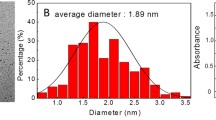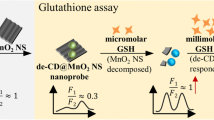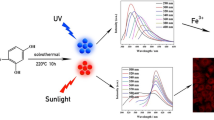Abstract
Manganese-doped carbon quantum dots (MnCQDs) were prepared through one-step hydrothermal method using citric acid and manganese tetraphenyl porphyrin as carbon sources in aqueous media. The structure of MnCQDs was confirmed by TEM, XRD, and XPS. The MnCQDs display a typical excitation-dependent emission behavior and exhibit bright green luminescence (with a peak at 482 nm) under UV irradiation (365 nm) and a fluorescence quantum yield of 13%. The MnCQDs can be used as a fluorescent probe for ferric ion in aqueous solution with a 220 nM detection limit. The MTT assay demonstrated the low cytotoxicity of MnCQDs towards HeLa cells. Due to the excitation-dependent emission properties, MnCQDs can be used as a multi-color (blue, green, and red) bioimaging agent in cancer cells and in living zebrafish. The application of MnCQDs as selective biosensing probe for Fe3+ was also realized in cells and zebrafish mode. Because of the existence of paramagnetic ions, MnCQDs demonstrate an enhanced magnetic resonance (MR) signal. Thus, the MnCQDs can serve as a positive contrast agent for MR imaging.

Schematic presentation of the preparation of luminescent manganese-doped carbon quantum dots (MnCQDs). MnCQDs showed good magnetic resonance effect and can be used as a fluorescence probe for the detection of Fe3+ in HeLa cells and zebrafish.






Similar content being viewed by others
References
Qian Z, Shan X, Chai L, Ma J, Chen J, Feng H (2014) Si-doped carbon quantum dots: a facile and general preparation strategy, bioimaging application, and multifunctional sensor. ACS Appl Mater Interfaces 6:6797–6805. https://doi.org/10.1021/am500403n
Perez A, Bardotti L, Prevel B, Jensen P, Treilleux M, Mélinon P, Gierak J, Faini G, Mailly D (2002) Quantum-dot systems prepared by 2D organization ofnanoclusters preformed in the gas phase on functionalizedsubstrates. New J Phys 4:76. https://doi.org/10.1088/1367-2630/4/1/376
Zhao S, Lan M, Zhu X, Xue H, Ng TW, Meng X, Lee CS, Wang P, Zhang W (2015) Green synthesis of Bifunctional fluorescent carbon dots from garlic for cellular imaging and free radical scavenging. ACS Appl Mater Interfaces 7:17054–17060. https://doi.org/10.1021/acsami.5b03228
Hsu PC, Chen PC, Ou CM, Chang HY, Chang HT (2013) Extremely high inhibition activity of photoluminescent carbon nanodots toward cancer cells. J Mater Chem B 1:1774–1781. https://doi.org/10.1039/c3tb00545c
Wu F, Su H, Cai Y, Wong WK, Jiang W, Zhu X (2018) Porphyrin-implanted carbon Nanodots for Photoacoustic imaging and in vivo breast Cancer ablation. ACS Appl Bio Mater 1:110–117. https://doi.org/10.1021/acsabm.8b00029
Ying LS, Wei S (2015) Carbon quantum dots and their applications. Chem Soc Rev 44:362–381
Gather MC, Reineke S (2015) Recent advances in light outcoupling from white organic light-emitting diodes. J Photonics Energy 5:057607. https://doi.org/10.1117/1.JPE.5.057607
Zhao A, Chen Z, Zhao C, Gao N, Ren J, Qu X (2015) Recent advances in bioapplications of C-dots. Carbon 85:309–327. https://doi.org/10.1016/j.carbon.2014.12.045
Dong Y, Wang R, Li G, Chen C, Chi Y, Chen G (2012) Polyamine-functionalized carbon quantum dots as fluorescent probes for selective and sensitive detection of copper ions. Anal Chem 84:6220–6224. https://doi.org/10.1021/ac3012126
Wu F, Yue L, Su H, Wang K, Yang L, Zhu X (2018) Carbon dots @ platinum Porphyrin composite as Theranostic Nanoagent for efficient photodynamic Cancer therapy. Nanoscale Res Lett 13:357
Xin L, Pan J, Feng X, Zhang X (2016) Simple approach to synthesize amino-functionalized carbon dots by carbonization of chitosan. Sci Rep 6:31100. https://doi.org/10.1038/srep36222
Pei S, Cheng HM (2012) The reduction of graphene oxide. Carbon 50:3210–3228. https://doi.org/10.1016/j.carbon.2011.11.010
Qian Z, Ma J, Shan X, Feng H, Shao L, Chen J (2014) Highly luminescent N-doped carbon quantum dots as an effective multifunctional fluorescence sensing platform. Chem Eur J 20:2254–2263. https://doi.org/10.1002/chem.201304374
Su H, Liao Y, Wu F, Sun X, Liu H, Wang K, Zhu X (2018) Cetuximab-conjugated iodine doped carbon dots as a dual fluorescent/CT probe for targeted imaging of lung cancer cells. Colloid Surf B 170:194–200
Zhang Y, Wang Y, Jia J, Wang J (2012) Nonenzymatic glucose sensor based on graphene oxide and electrospun NiO nanofibers. Sens Actuators B Chem 171:580–587
Wu F, Su H, Zhu X, Wang K, Zhang Z, Wong WK (2016) Near-infrared emissive lanthanide hybridized carbon quantum dots for bioimaging applications. J Mater Chem B 4:6366–6372. https://doi.org/10.1039/C6TB01646D
Wu F, Yue L, Yang L, Wang K, Liu G, Luo X, Zhu X (2018) Ln(III) chelates-functionalized carbon quantum dots: synthesis, optical studies and multimodal bioimaging applications. Colloid Surf B 175:272–280
Liu R, Huang H, Li H, Liu Y, Zhong J, Li Y, Zhang S, Kang Z (2014) Metal nanoparticle/carbon quantum dot composite as a Photocatalyst for high-efficiency cyclohexane oxidation. ACS Catal 4:328–336
Sun S, Guan Q, Liu Y, Wei B, Yang Y, Yu Z (2019) Highly luminescence manganese doped carbon dots. Chin Chem Lett. https://doi.org/10.1016/j.cclet.2019.01.014
Dhenadhayalan N, Lin KC (2015) Chemically induced fluorescence switching of carbon-dots and its multiple logic gate implementation. Sci Rep 5:10012. https://doi.org/10.1038/srep10012
Wu F, Su H, Wang K, Wong WK, Zhu X (2017) Facile synthesis of N-rich carbon quantum dots from porphyrins as efficient probes for bioimaging and biosensing in living cells. Int J Nanomedicine 12:7375–7391
Yuan S, Wang F, Yang G, Lu C, Nie J, Chen Z, Ren J, Qiu Y, Sun Q, Zhao C, Zhu WH (2018) Highly sensitive Ratiometric self-assembled Micellar Nanoprobe for Nitroxyl and its application in vivo. Anal Chem 90:3914–3919. https://doi.org/10.1021/acs.analchem.7b04787
Zhou Z, Wang F, Yang G, Lu C, Nie J, Chen Z, Ren J, Sun Q, Zhao C, Zhu WH (2017) A Ratiometric fluorescent probe for monitoring Leucine Aminopeptidase in living cells and Zebrafish model. Anal Chem 89:11576–11582. https://doi.org/10.1021/acs.analchem.7b02910
Fan Y, Cheng H, Zhou C, Xie X, Liu Y, Dai L, Zhang J, Qu L (2012) Honeycomb architecture of carbon quantum dots: a new efficient substrate to support gold for stronger SERS. Nanoscale 4:1776–1781. https://doi.org/10.1039/c2nr12015a
Soomro RA, Nafady A, Sirajuddin MN, Sherazi TH, Kalwar NH (2014) L -cysteine protected copper nanoparticles as colorimetric sensor for mercuric ions. Talanta 130:415–422. https://doi.org/10.1016/j.talanta.2014.07.023
Xu X, Ray R, Gu Y, Ploehn HJ, Gearheart L, Raker K (2015) Electrophoretic analysis and purification of fluorescent single-walled carbon nanotube fragments. J Am Chem Soc 126:12736–12737
Liu Y, Liu C, Zhang Z (2012) Synthesis of highly luminescent graphitized carbon dots and the application in the Hg2+ detection. Appl Surf Sci 263:481–485. https://doi.org/10.1016/j.apsusc.2012.09.088
Sharma V, Saini AK, Shaikh MM (2016) Multicolour fluorescent carbon nanoparticle probes for live cell imaging cum dual palladium and mercury sensor. J Mater Chem B 4:2466–2476. https://doi.org/10.1039/C6TB00238B
Liu Y, Zhao Y, Zhang Y (2014) One-step green synthesized fluorescent carbon nanodots from bamboo leaves for copper(II) ion detection. Sensors Actuators B Chem 196:647–652. https://doi.org/10.1016/j.snb.2014.02.053
Cayuela A, Soriano ML, Valcárcel M (2015) Photoluminescent carbon dot sensor for carboxylated multiwalled carbon nanotube detection in river water. Sensors Actuators B Chem 207:596–601. https://doi.org/10.1016/j.snb.2014.10.102
Wu F, Yang M, Zhang H, Zhu S, Zhu X, Wang K (2018) Facile synthesis of sulfur-doped carbon quantum dots from vitamin B1 for highly selective detection of Fe3+ ion. Opt Mater 77:258–263. https://doi.org/10.1016/j.optmat.2018.01.048
Yang Q, Wei L, Zheng X, Xiao L (2015) Single particle dynamic imaging and Fe3+ sensing with bright carbon dots derived from bovine serum albumin proteins. Sci Rep 5:17727. https://doi.org/10.1038/srep18583
Sun Q, Yang SH, Wu L, Dong QJ, Yang WC, Yang GF (2016) Detection of intracellular Selenol-containing molecules using a fluorescent probe with near-zero background signal. Anal Chem 88:6084–6091. https://doi.org/10.1021/acs.analchem.6b01545
Adams RD, Layland R, Payen C (1996) A new manganese ortho-arsenate. The synthesis, structure and magnetic properties of Ba 2 Mn(AsO4)2. Polyhedron 15:1235–1239. https://doi.org/10.1016/0277-5387(95)00383-5
Wu F, Chen J, Li Z, Su H, Leung KCF, Wang H, Zhu X (2018) Red/near-infrared emissive Metalloporphyrin-based Nanodots for magnetic resonance imaging-guided photodynamic therapy in vivo. Part Part Syst Charact 35:1800208. https://doi.org/10.1002/ppsc.201800208
Acknowledgments
We are thankful for the support from National Natural Science Foundation of China (grant no. 21601142, 21804102), Natural Science Foundation of Hubei Province (grant no. 2018CFB159, 2017CFB222) and the 10th Graduate Innovative Fund of Wuhan Institute of Technology (CX2018005).
Author information
Authors and Affiliations
Corresponding authors
Ethics declarations
The author(s) declare that they have no competing interests.
Additional information
Publisher’s note
Springer Nature remains neutral with regard to jurisdictional claims in published maps and institutional affiliations.
Electronic supplementary material
ESM 1
(DOCX 474 kb)
Rights and permissions
About this article
Cite this article
Yue, L., Li, H., Liu, Q. et al. Manganese-doped carbon quantum dots for fluorometric and magnetic resonance (dual mode) bioimaging and biosensing. Microchim Acta 186, 315 (2019). https://doi.org/10.1007/s00604-019-3407-8
Received:
Accepted:
Published:
DOI: https://doi.org/10.1007/s00604-019-3407-8




